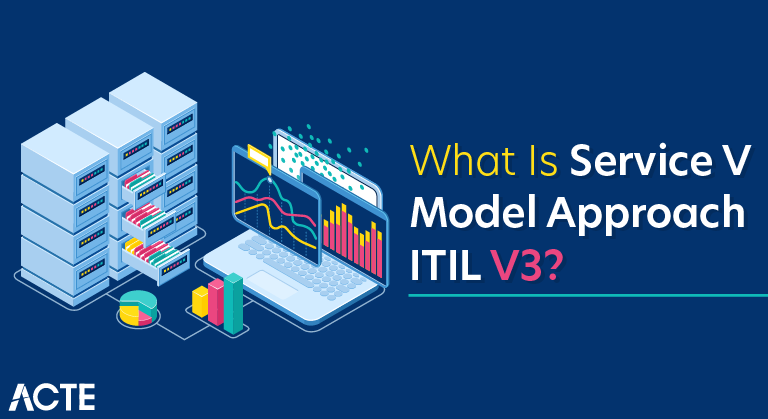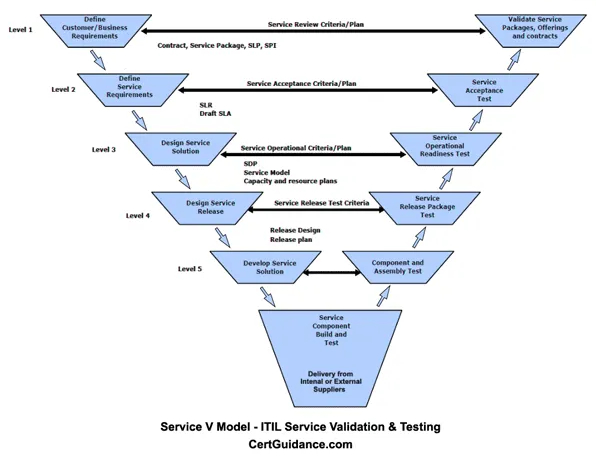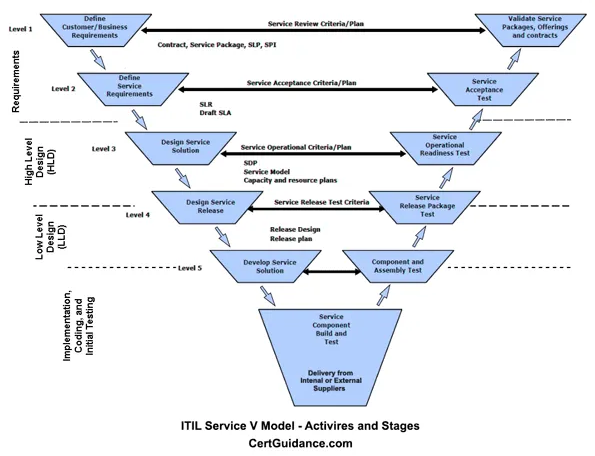
What Is Service V Model approach ITIL v3? – Learning Guide
Last updated on 15th Jul 2020, Blog, General
- The ITIL Service V Model is a concept described under the ITIL Service Validation and Testing process. This is sometimes also called the ITIL V Model.
- This V Model concept helps to define the appropriate requirements and appropriate validation methods that have to be taken care of by the developer of service.
Properties of Service V Model – ITIL V3:
- Below lists some important properties of ITIL Service V Model:
- The Service V Model, in ITIL V3, is a unique concept that provides a well-defined path to mention the service requirements of a service package, designing & building of a package, and then testing the package.
- The ITIL V Model approach is traditionally related to the waterfall lifecycle model but you can apply it with conjunction with other approaches as well.
- This model provides baseline points along the testing path that are used as checkpoints to compare the service being designed, built and delivered versus what was actually estimated/required.
- The ITIL Service V Model technique provides a solid framework for Service Validation and Testing, which helps to define the levels of Configuration Items (CIs) that are needed in each stage and the corresponding testing and validation procedures needed to be followed.
ITIL Service V Model Process Flow:
- The ITIL V-Model illustrates the relationships between each phase of the software/service development life cycle and its associated phase of testing.
- During each phase of software/service development, you must fully complete one test procedure before proceeding to the next one. For example, to move to the “service release package test” you must first complete the “component and assembly test” and take and sign off from the appropriate authority.
- Additionally, testing of each software/service happens at different levels, first component testing, then package testing, operational readiness testing etc which facilitates early detection of errors.
- All the testing levels are derived by observing the way a system is designed and built up. The ITIL Service V Model provides a framework on how the Service Transition levels of testing can be paired with the matching stages of service requirements and design.
The below image shows the ITIL Service V Model process flow in detail:

- The left-hand side of the V-Model picture represents the high-level business requirements, and right-hand side shows the validation & testing methods to be applied.
- Ideally, in the ITIL V-Model, the design of a service is performed in a top-down approach, while the testing is performed in the bottom-up approach.
ITIL Service V Model Activities and Stages:
The various activities and stages of the ITIL Service V-Model are as follows:
Requirements Gathering:
- All activities related to gathering requirements, such as business requirement and system requirement, are collectively defined under the requirement stage of ITIL V Model.
- This stage is the combination of Level 1 and Level 2 activities.
- This is very similar to the waterfall model. But in this V-Model, before development is started, a system test plan is created to test all the functionalities specified in the requirements gathering stage.
High-Level Design (HLD):
- The high-level design (HLD) phase is mostly focused on the activities needed to define the system architecture and design.
- This stage is used to provide an overview of the solution, platform, system, product, process, and service.
- The test plan used here is called a system readiness test or integration test, which shows the operational readiness of the developed item.
- This stage combines the Level 3 activities and some part of Level 4 activities.
Low-Level Design (LLD):
- Activities in the low-level design (LLD) stage relates to the actions performed to develop a detailed and granular design of the actual service/software component.
- An LLD defines the actual logic for every single component of the system.
- The testing plan that is practiced at this stage is termed as “Component test”.
- This stage contains part of Level 4 activities along with part of Level 5 Activities.
Implementation and Coding:
- The Implementation and coding phase in ITIL Service V Model is where all coding takes place.
- Here implementation doesn’t mean deployment; instead, it means implementation of the Low-level development plan.
- Once coding is complete, the Unit test and Build tests are done to check the working of each of the individual components.
- This stage follows a part of Level 5 activities and the activities performed at the bottom level of ITIL V Model.
The below image shows and illustrates the mapping between V Model activities and Levels.

Advantages of ITIL Service V Model:
- A testing model that is very simple and easy to use.
- Planning for testing activities like defining acceptance criteria, test designing etc happens well before coding. This possesses a higher chance of success over the waterfall model.
- Proactive defect tracking is integrated into every stage – hence defects are found at the early stage.
- This also restricts the downward flow of the defects.
- Works quite well for small development projects where requirements are easily understood.
Disadvantages of ITIL Service V Model:
- The flow of activities is very rigid and somewhat least flexible.
- The actual service/software is developed during the implementation and coding phase, so NO early prototypes are produced.
- In case any change of requirement arises midway, then all the test documents, test plans, along with project requirement documents need to be freshly updated.
Why and When You Should Use the ITIL Service V Model:
- The ITIL Service V Model helps to determine and mitigate risks at the very early stage. So you will face fewer issues that are caused by unpredictable risks.
- This V Model encourages the team to document the entire customer requirements in a standard format, which helps to understand and estimate the funding requirement.
- The ITIL V Model should be used to carry out small to medium sized projects where all the requirements are clearly defined and fixed.
- You should choose the V Model, only if you have ample technical resources available with needed technical expertise.
- You must take this approach only if the customer has a high level of confidence in your company. Since no early prototypes are produced; there is a risk of rejection after the entire development is done.
